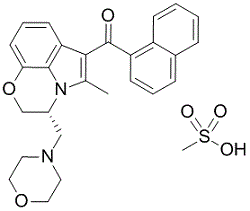| Cas No.: | 131543-23-2 |
| Chemical Name: | WIN552122,WIN-552122 |
| Synonyms: | WIN552122,WIN-552122 |
| SMILES: | C([C@@H]1C(CN2CCOCC2)N2C(C)=CC3=C2C(=CC=C3)O1)(C1=C2C(C=CC=C2)=CC=C1)=O.OS(C)(=O)=O |
| Formula: | C28H30N2O6S |
| M.Wt: | 522.61 |
| Sotrage: | 2 years -20°C Powder, 2 weeks 4°C in DMSO, 6 months -80°C in DMSO |
| Description: | WIN 55,212-2 Mesylate is a potent aminoalkylindole cannabinoid (CB) receptor agonist with Kis of 62.3 and 3.3 nM for human recombinant CB1 and CB2 receptors, respectively. |
| In Vivo: | In the prefrontal cortex WIN 55,212-2 (0.1 and 1 mg/kg i.p.) increases dialysate glutamate levels from of the awake rat, while the lower (0.01 mg/kg) and the higher (2 mg/kg) doses are ineffective. Furthermore, the WIN 55,212-2 (0.1 mg/kg)- induced increase of dialysate glutamate levels is counteracted by pretreatment with the selective CB(1) receptor antagonist SR141716A (0.1 mg/kg, i.p.) and by the local perfusion with a low-calcium Ringer solution (Ca2+ 0.2 mM)[2]. WIN 55,212-2 (0.5, 1, 3, 5, 10 and 15 mg/kg, i.p.) does not alter the seizure threshold at low doses, while higher doses of the drug significantly increases the threshold in a dose-dependent manner. The anticonvulsant effect of WIN 55,212-2, which is observed with doses as high as 5 mg/kg, can be observed with doses as low as 0.5 mg/kg in groups pre-treated with 20 mg/kg of pioglitazone[4]. |
| In Vitro: | WIN 55,212-2 is more potent in CHO-CB2 cells than in CHO-CB1 cells by a factor of 6O. WIN 55,212-2 has no effect on arachidonic acid release in CHO-CB2 or control CHO cells. WIN 55,212-2 fails to stimulate any increase in intracellular Ca2+ up to 10 μM[1]. In primary cultures of rat cerebral cortex neurons, WIN 55,212-2 (0.01--100 nM) increases extracellular glutamate levels, displaying a bell-shaped concentration-response curve. The facilitatory effect of WIN 55,212-2 (1 nM) is fully counteracted by SR141716A (10 nM), by the replacement of the normal Krebs Ringer-bicarbonate buffer with a low Ca2+ medium (0.2 mM) and by the IP(3) receptor antagonist xestospongin C (1 μM)[2]. WIN 55,212-2 evokes CGRP release from TG neurons in vitro (EC50=26 μM) in a concentration- and calcium-dependent manner. WIN 55,212-2-2 neither inhibits capsaicin-evokes CGRP release nor does it inhibit forskolin-, isoproteranol- or prostaglandin E2-stimulated cAMP accumulation. WIN 55,212-2 significantly inhibits (EC50=1.7 μM) 50 mm K+-evoked CGRP release by approximately 70%. WIN 55,212-2 inhibition of 50 mm K+-evoked CGRP release is not reversed by antagonists of cannabinoid type 1 (CB1) receptor, but is mimicks in magnitude and potency (EC50=2.7 μM) by its cannabinoid-inactive enantiomer WIN 55,212-2-3[3]. |

 DC Chemicals' products qualify for U.S. tariff exemptions. We guarantee no price increases due to customs duties and maintain stable supply, continuing to deliver reliable research solutions to our American clients.
DC Chemicals' products qualify for U.S. tariff exemptions. We guarantee no price increases due to customs duties and maintain stable supply, continuing to deliver reliable research solutions to our American clients.





















